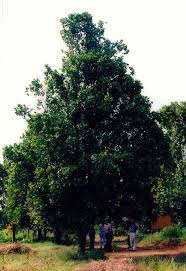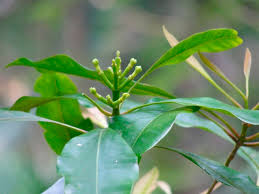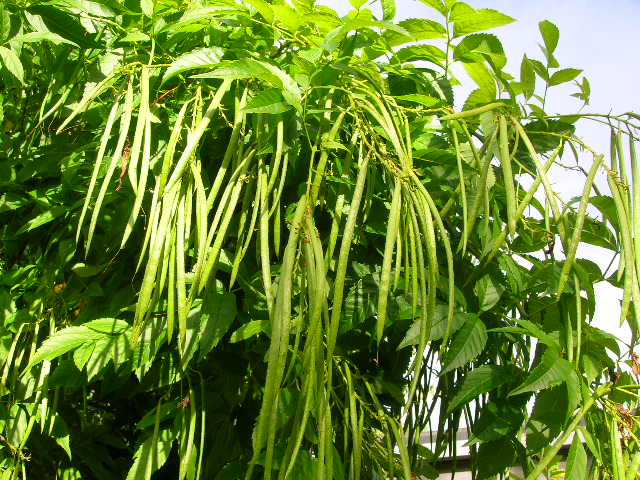Cloves
Indian/Sanskrit Lavanga, Devakusuma
கிராம்பு
Japanese: Choji -- Chinese: Ding xiang, Ting hsiang, Ding heung

This pyramidal evergreen clove tree, grows up to 15 to 30 feet tall, has smooth grey bark and ovate 5 inches long leaves with small bell-shaped white flowers which grow in terminal clusters. The flower buds are greenish and turn pink at maturity. The seeds are oblong, soft, grooved on one side.
Cloves are the dried, unopened flower buds of the evergreen clove tree. This small reddish-brown flower bud resembles a tiny nail head. The name clove is believed to be derived either from the Latin word 'clavus' or the French word 'clou' which means nail. It is native to Moluccas or Spice Islands (Indonesia) but is also grown in India, Sumatra, Jamaica, the West Indies, Brazil and other tropical areas.

All parts of the clove tree are highly aromatic.
Dried flower bud, which gives a sharp and spicy flavour, either whole or ground are used for culinary purposes.
It is one of the most important drugs used in indigenous medicine in India, especially in Unani medicine.
Clove is reported as an aphrodisiac, stomachic, carminative, and antispasmodic.
It is reported to be useful in conceiving in high doses and act as a contraceptive in low doses and useful in cataract. Clove is also reported to have anticarcinogenic property.
It possesses antiviral activity against Herpes simplex
.
Medicinal parts used:
Therapeutic use:
• Clove oil has got analgesic properties and applied locally in swollen gum and in toothache.
• The use of clove in food and condiments triggers the body to secrete antioxidant enzymes which prevents the body from oxidative damage.
• Reduces the excess fat and lipid from the body.
• Clove oil has good antiviral, antibacterial properties and used in traditional medicine as a bactericide, fungicide, can prevent the body from infections and is a good antiseptic.
Ceylon Cloves
It is an aromatic flower bud of a tree in the family Myrtaceae. It is used as
spice in cuisine all over the world. Clove tree is an evergreen tree whose height
ranges from 10-20 m. Apart from being used in cuisine; clove is also used in

other industries for its medicinal use and
therapeutic value.

Toxicity:
Large amounts should be avoided in pregnancy. Cloves can be irritating to the gastrointestinal tract, and should be avoided by people with gastric ulcers, colitis, or irritable bowel syndrome. In overdoses - sometimes referred to with the neologism 'clover doses' - cloves can cause vomiting, nausea, diarrhoea, and upper gastrointestinal haemorrhages. Severe overuse can lead to kidney failure, changes in liver function, dyspnea, loss of consciousness, hallucination, and even death.Thanks to
Indian/Sanskrit Lavanga, Devakusuma
கிராம்பு
Japanese: Choji -- Chinese: Ding xiang, Ting hsiang, Ding heung
This pyramidal evergreen clove tree, grows up to 15 to 30 feet tall, has smooth grey bark and ovate 5 inches long leaves with small bell-shaped white flowers which grow in terminal clusters. The flower buds are greenish and turn pink at maturity. The seeds are oblong, soft, grooved on one side.
Cloves are the dried, unopened flower buds of the evergreen clove tree. This small reddish-brown flower bud resembles a tiny nail head. The name clove is believed to be derived either from the Latin word 'clavus' or the French word 'clou' which means nail. It is native to Moluccas or Spice Islands (Indonesia) but is also grown in India, Sumatra, Jamaica, the West Indies, Brazil and other tropical areas.
Nutrients in Cloves
Cloves (Eugenia aromatica) are an excellent source of manganese. They are a very good source of vitamin C, K, and dietary fiber. They are a good source of calcium and magnesium.
All parts of the clove tree are highly aromatic.
Dried flower bud, which gives a sharp and spicy flavour, either whole or ground are used for culinary purposes.
It is one of the most important drugs used in indigenous medicine in India, especially in Unani medicine.
Clove is reported as an aphrodisiac, stomachic, carminative, and antispasmodic.
It is reported to be useful in conceiving in high doses and act as a contraceptive in low doses and useful in cataract. Clove is also reported to have anticarcinogenic property.
It possesses antiviral activity against Herpes simplex
.
Medicinal parts used:
Therapeutic use:
• Clove oil has got analgesic properties and applied locally in swollen gum and in toothache.
• The use of clove in food and condiments triggers the body to secrete antioxidant enzymes which prevents the body from oxidative damage.
• Reduces the excess fat and lipid from the body.
• Clove oil has good antiviral, antibacterial properties and used in traditional medicine as a bactericide, fungicide, can prevent the body from infections and is a good antiseptic.
Ceylon Cloves
It is an aromatic flower bud of a tree in the family Myrtaceae. It is used as
spice in cuisine all over the world. Clove tree is an evergreen tree whose height
ranges from 10-20 m. Apart from being used in cuisine; clove is also used in
other industries for its medicinal use and
therapeutic value.
Toxicity:
Large amounts should be avoided in pregnancy. Cloves can be irritating to the gastrointestinal tract, and should be avoided by people with gastric ulcers, colitis, or irritable bowel syndrome. In overdoses - sometimes referred to with the neologism 'clover doses' - cloves can cause vomiting, nausea, diarrhoea, and upper gastrointestinal haemorrhages. Severe overuse can lead to kidney failure, changes in liver function, dyspnea, loss of consciousness, hallucination, and even death.Thanks to
Clove is an important ingredient in Japanese incense. Cloves are extremely stimulating and refreshing.
Clove is the common name for the tropical tree, Syzygium aromaticum, of the family Myrtaceae. The clove tree is native to North Moluccas (Indonesia) It was replanted to several other islands by the Dutch and later introduced to Zanzibar and Madagascar.
The clove tree is a evergreen with small white flower which grow in clusters. The flower buds are gathered and dried. Clove is used in the famous Worcestershire sauce and extensively as a spice in cooking.
Cloves are said to have antiseptic properties and are used as a preservative in pickles among other things. Ancient Chinese civilization chewed Cloves to sweeten their breath before talking to the emperor. Cloves and "Oil of Clove" have also been used as a mild anesthetic for toothaches. It could be one of Mother Nature's premium antiseptics!
Cloves as an Aphrodisiac
Extract of clove has been shown to enhance the sexual behavior of male mice. The results of the study resulted in a significant and sustained increase in the sexual activity of normal male rats, without any adverse effects. The results seem to support the claims for its traditional usage as an aphrodisiac.
Cloves as Mosquito Repellant
The natural oil of clove is a natural mosquito repellant and can give protection against mosquitoes for4-5 hours.
Cloves for Cancer Prevention
Preliminary studies have suggested the chemopreventive potential of clove for lung cancer, and to delay and reduce the formation of skin cancer.
Cloves for Cardiovascular Health
The compound eugenol from cloves has been found to be a potent platelet inhibitor (prevents blood clots).
Adverse Reactions from Cloves
Allergic reactions to clove and eugenol have been reported.
Clove supplements should be avoided in children and pregnant or nursing women.Thanks Elements 4 health


